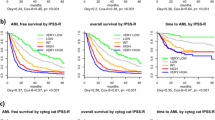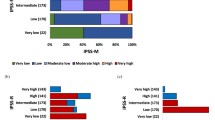Abstract
While therapy-related (t)-myelodysplastic syndromes (MDS) have worse outcomes than de novo MDS (d-MDS), some t-MDS patients have an indolent course. Most MDS prognostic models excluded t-MDS patients during development. The performances of the International Prognostic Scoring System (IPSS), revised IPSS (IPSS-R), MD Anderson Global Prognostic System (MPSS), WHO Prognostic Scoring System (WPSS) and t-MDS Prognostic System (TPSS) were compared among patients with t-MDS. Akaike information criteria (AIC) assessed the relative goodness of fit of the models. We identified 370 t-MDS patients (19%) among 1950 MDS patients. Prior therapy included chemotherapy alone (48%), chemoradiation (31%), and radiation alone in 21%. Median survival for t-MDS patients was significantly shorter than for d-MDS (19 vs 46 months, P<0.005). All models discriminated survival in t-MDS (P<0.005 for each model). Patients with t-MDS had a significantly higher hazard of death relative to d-MDS in every risk model, and had inferior survival compared to patients with d-MDS within all risk group categories. AIC Scores (lower is better) were 2316 (MPSS), 2343 (TPSS), 2343 (IPSS-R), 2361 (WPSS) and 2364 (IPSS). In conclusion, subsets of t-MDS patients with varying clinical outcomes can be identified using conventional risk stratification models. The MPSS, TPSS and IPSS-R provide the best predictive power.
This is a preview of subscription content, access via your institution
Access options
Subscribe to this journal
Receive 12 print issues and online access
$259.00 per year
only $21.58 per issue
Buy this article
- Purchase on Springer Link
- Instant access to full article PDF
Prices may be subject to local taxes which are calculated during checkout



Similar content being viewed by others
References
Zeidan AM, Linhares Y, Gore SD . Current therapy of myelodysplastic syndromes. Blood Rev 2013; 27: 243–259.
Vardiman JW, Thiele J, Arber DA, Brunning RD, Borowitz MJ, Porwit A et al. The 2008 revision of the World Health Organization (WHO) classification of myeloid neoplasms and acute leukemia: rationale and important changes. Blood 2009; 114: 937–951.
Larson RA . Cytogenetics, not just previous therapy, determines the course of therapy-related myeloid neoplasms. J Clin Oncol 2012; 30: 2300–2302.
Churpek JE, Larson RA . The evolving challenge of therapy-related myeloid neoplasms. Best Pract Res Clin Haematol 2013; 26: 309–317.
Granfeldt Ostgard LS, Medeiros BC, Sengelov H, Norgaard M, Andersen MK, Dufva IH et al. Epidemiology and clinical significance of secondary and therapy-related acute myeloid leukemia: a National Population-Based Cohort Study. J Clin Oncol 2015; 33: 3641–3649.
Kaplan H, Malmgren J, De Roos AJ . Risk of myelodysplastic syndrome and acute myeloid leukemia post radiation treatment for breast cancer: a population-based study. Breast Cancer Res Treat 2013; 137: 863–867.
Wolff AC, Blackford AL, Visvanathan K, Rugo HS, Moy B, Goldstein LJ et al. Risk of marrow neoplasms after adjuvant breast cancer therapy: the national comprehensive cancer network experience. J Clin Oncol 2015; 33: 340–348.
Zeidan AM, Komrokji RS . There's risk, and then there's risk: The latest clinical prognostic risk stratification models in myelodysplastic syndromes. Curr Hematol Malig Rep 2013; 8: 351–360.
Faltas B, Zeidan A, Gergis U . Myelodysplastic syndromes: toward a risk-adapted treatment approach. Expert Rev Hematol 2013; 6: 611–624.
Greenberg P, Cox C, LeBeau MM, Fenaux P, Morel P, Sanz G et al. International scoring system for evaluating prognosis in myelodysplastic syndromes. Blood 1997; 89: 2079–2088.
Greenberg PL, Tuechler H, Schanz J, Sanz G, Garcia-Manero G, Sole F et al. Revised international prognostic scoring system for myelodysplastic syndromes. Blood 2012; 120: 2454–2465.
Malcovati L, Germing U, Kuendgen A, Della Porta MG, Pascutto C, Invernizzi R et al. Time-dependent prognostic scoring system for predicting survival and leukemic evolution in myelodysplastic syndromes. J Clin Oncol 2007; 25: 3503–3510.
Kantarjian H, O'Brien S, Ravandi F, Cortes J, Shan J, Bennett JM et al. Proposal for a new risk model in myelodysplastic syndrome that accounts for events not considered in the original International Prognostic Scoring System. Cancer 2008; 113: 1351–1361.
Lee EJ, Podoltsev N, Gore SD, Zeidan AM . The evolving field of prognostication and risk stratification in MDS: Recent developments and future directions. Blood Rev 2016; 30: 1–10.
Zeidan AM, Stahl M, Komrokji R . Emerging biological therapies for the treatment of myelodysplastic syndromes. Expert Opin Emerg Drugs. 2016; 21: 283–300.
Singh ZN, Huo D, Anastasi J, Smith SM, Karrison T, Le Beau MM et al. Therapy-related myelodysplastic syndrome: morphologic subclassification may not be clinically relevant. Am J Clin Pathol 2007; 127: 197–205.
Quintas-Cardama A, Daver N, Kim H, Dinardo C, Jabbour E, Kadia T et al. A prognostic model of therapy-related myelodysplastic syndrome for predicting survival and transformation to acute myeloid leukemia. Clin Lymphoma Myeloma Leuk 2014; 14: 401–410.
Breccia M, Fianchi L, Lunghi M, Gaidano G, Levis A, Finelli C et al. Newly proposed therapy-related myelodysplastic syndrome prognostic score predicts significant differences in overall survival and leukemia-free survival in patients treated with azacitidine. Leuk Lymphoma 2013; 54: 1786–1787.
Cheson BD, Greenberg PL, Bennett JM, Lowenberg B, Wijermans PW, Nimer SD et al. Clinical application and proposal for modification of the International Working Group (IWG) response criteria in myelodysplasia. Blood 2006; 108: 419–425.
Klimek VM, Dolezal EK, Tees MT, Devlin SM, Stein K, Romero A et al. Efficacy of hypomethylating agents in therapy-related myelodysplastic syndromes. Leuk Res 2012; 36: 1093–1097.
Duong VH, Lancet JE, Alrawi E, Al-Ali NH, Perkins J, Field T et al. Outcome of azacitidine treatment in patients with therapy-related myeloid neoplasms with assessment of prognostic risk stratification models. Leuk Res 2013; 37: 510–515.
Bally C, Thepot S, Quesnel B, Vey N, Dreyfus F, Fadlallah J et al. Azacitidine in the treatment of therapy related myelodysplastic syndrome and acute myeloid leukemia (tMDS/AML): a report on 54 patients by the Groupe Francophone Des Myelodysplasies (GFM). Leuk Res 2013; 37: 637–640.
Nardi V, Winkfield KM, Ok CY, Niemierko A, Kluk MJ, Attar EC et al. Acute myeloid leukemia and myelodysplastic syndromes after radiation therapy are similar to de novo disease and differ from other therapy-related myeloid neoplasms. J Clin Oncol 2012; 30: 2340–2347.
Abou Zahr A, Kavi AM, Mukherjee S, Zeidan AM . Therapy-related myelodysplastic syndromes, or are they? Blood Rev, e-pub ahead of print 24 November 2016; doi:10.1016/j.blre.2016.11.002.
Wang R, Zeidan AM, Yu JB, Soulos PR, Davidoff AJ, Gore SD et al. Myelodysplastic syndromes and acute myeloid leukemia after radiotherapy for prostate cancer: a population-based study. Prostate, e-pub ahead of print 21 November 2016; doi:10.1002/pros.23281.
Zeidan A, Davidoff A, Long J, Hu X, Wang R, Ma X et al. Comparative clinical effectiveness of azacitidine versus decitabine in older patients with myelodysplastic syndromes. Br J Haematol 2016; 175: 829–840.
Zeidan A, Sekeres M, Garcia-Manero G, Steensma DP, Zell K, Barnard J et al. Comparison of risk stratification tools in predicting outcomes of patients with higher-risk myelodysplastic syndromes treated with azanucleosides. Leukemia 2016; 30: 649–657.
Zeidan A, Wang R, Gross C, Gore S, Huntington S, Prebet T et al. Modest improvement in survival of patients with refractory anemia with excess blasts in the hypomethylating agents era in the United States. Leuk Lymphoma 2016; 58: 982–985.
Zeidan A, Sekeres M, Wang X, Al Ali N, Garcia-Manero G, Steensma D et al. Comparing the prognostic value of risk stratifying models for patients with lower-risk myelodysplastic syndromes: is one model better? Am J Hematol 2015; 90: 1036–1040.
Abou Zahr A, Bernabe Ramirez C, Wozney J, Prebet T, Zeidan A . New insights into the pathogenesis of MDS and the rational therapeutic opportunities. Expert Rev Hematol 2016; 9: 377–388.
Nazha A, Sekeres M, Gore S, Zeidan A . Molecular testing in myelodysplastic syndromes for the practicing oncologist: will the progress fulfill the promise? Oncologist 2015; 20: 1069–1076.
Bejar R . Implications of molecular genetic diversity in myelodysplastic syndromes. Curr Opin Hematol 2017; 24: 73–78.
Gillis N, Ball M, Zhang Q, Ma Z, Zhao Y, Yoder S et al. Clonal haemopoiesis and therapy-related myeloid malignancies in elderly patients: a proof-of-concept, case-control study. Lancet Oncol 2016; 18: 112–121.
Acknowledgements
Funding for this research has been provided, in part from the Edward P. Evans Foundation to EP, MAS, DPS, AD, GR, GGM and RK.
Author contributions
AMZ designed the research, interpreted the data and wrote the manuscript. RK designed the research, supervised data analysis, interpreted the data, and critically revised the manuscript. JB analyzed the data and contributed to manuscript writing. NAA, EP, JEL, MAS, DPS, AD, GR, EJ, GGM, and AL reviewed the data and critically reviewed and contributed to the manuscript significantly. All authors approved the final manuscript for submission.
Author information
Authors and Affiliations
Corresponding author
Ethics declarations
Competing interests
The authors declare no conflict of interest.
Additional information
Supplementary Information accompanies this paper on the Leukemia website
Supplementary information
Rights and permissions
About this article
Cite this article
Zeidan, A., Al Ali, N., Barnard, J. et al. Comparison of clinical outcomes and prognostic utility of risk stratification tools in patients with therapy-related vs de novo myelodysplastic syndromes: a report on behalf of the MDS Clinical Research Consortium. Leukemia 31, 1391–1397 (2017). https://doi.org/10.1038/leu.2017.33
Received:
Revised:
Accepted:
Published:
Issue Date:
DOI: https://doi.org/10.1038/leu.2017.33
This article is cited by
-
Therapy-related MDS dissected based on primary disease and treatment—a nationwide perspective
Leukemia (2023)
-
Therapy-related myelodysplastic syndromes deserve specific diagnostic sub-classification and risk-stratification—an approach to classification of patients with t-MDS
Leukemia (2021)
-
Which lower risk myelodysplastic syndromes should be treated with allogeneic hematopoietic stem cell transplantation?
Leukemia (2020)
-
The mutational burden of therapy-related myeloid neoplasms is similar to primary myelodysplastic syndrome but has a distinctive distribution
Leukemia (2019)
-
Risk of subsequent myeloid neoplasms after radiotherapy treatment for a solid cancer among adults in the United States, 2000–2014
Leukemia (2018)



